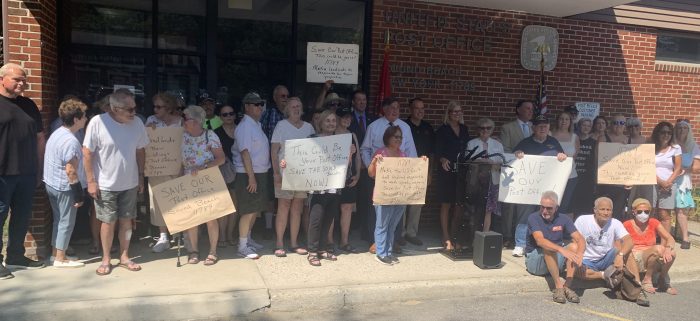The scope and size of The Stony Brook School’s proposed expansions
In response to your Stony Brook School article on Aug. 31 [See story, “The Stony Brook School submits application for new buildings as neighbors voice concerns”], please note a total of 95 signatures, not “over a dozen,” were submitted to the Town of Brookhaven Zoning Board at the Aug. 23 meeting opposing the indoor practice facility. You can review the video of that meeting on Channel 18 to see when I actually presented the board with the petition.
It is true that the Stony Brook School’s representatives — the lawyers and architect — presented an updated plan that we were only informed of the changes an hour before the case was called before the board, eliminating the access of the indoor sports facility from Chubb Hill Road and also eliminating the 14 proposed parking spots, which is good.
The new proposed access road will be at Quaker Path, pending the fire department’s approval. But the proposed size of the building itself is huge: 35,000 square feet and 46-feet tall.
It’s like a Costco smack in the middle of a residential neighborhood. A metal building of that size will significantly impact the aesthetics of the beautiful wooded area of old Stony Brook.
Please note that the proposed 35,000 square feet is 23,800 feet over the currently permitted size of 11,200 square feet. And the proposed 46-feet height is 11-feet taller than the currently allowed 35 feet. The school said they would do nice landscaping around the sports facility, but you can’t hide a 35,000-square-foot, 46-feet-high metal building.
The Stony Brook School only has approximately 400 students grades seven through 12, so the question is why such a large building is needed for a small student body when other schools in our area that have many more students do not have an indoor sports facility. Once the metal building is up, the local residents will be stuck with this monster of a building in our backyard.
Potentially The Stony Brook School can use this sports facility for any function sports or nonsporting event any time of day and night.
The school can also rent out the facility to outside groups, though the school’s representatives at the Zoning Board meeting said they would not do that.
I’m not so sure of their sincerity. The next ZBA meeting to discuss this proposal is on Wednesday, Sept. 20.
Hope Wolinski
Stony Brook
Polluted groundwater affects more than the tap
A recent letter by George Altemose [“An alternative to advanced septic systems,” Sept. 7, TBR News Media] suggested that instead of increasing Suffolk sales tax 1/8% to help fund upgraded, nitrogen-reducing septic tanks, it would be more cost effective to eliminate the nitrogen after it has already entered the groundwater. But only the groundwater that comes from Suffolk County Water Authority wells and into our homes as drinking water.
What about the polluted groundwater from old cesspools and septic systems that’s now going into our beaches, bays and other waterways, killing fish and creating dead zones?
Old cesspools and septic systems need replacing, and they should be replaced with upgraded, nitrogen-reducing systems and there are rebates and grants to help pay for it.
Another consideration, according to one local company’s website, is that the upgraded systems work best when homeowners use less water and fewer chemical cleaning products. So in the long run the homeowner will be motivated to reduce water use by running only full loads in the washing machine and dishwasher and to stop buying expensive cleaning products with harmful chemicals and instead make their own homemade cleaners using baking soda or white vinegar to prolong the life and improve the performance of their new, high-tech septic system.
Remember, we live on an island and there are grants and rebates to help pay for the upgraded systems because we all benefit from Long Island’s beautiful beaches and abundant wildlife.
Diane Ives
Copiague
Editor’s note: The writer serves on the executive committee of the Sierra Club Long Island Group.
SCWA can’t ward off algal blooms
While the Suffolk County Water Authority can do something about nitrogen in drinking water, it does not and cannot do anything to reduce the excessive amount of nitrogen in the drinking water of those of us that get our water from our own wells, nor can it do anything to reduce the amount of nitrogen in our lakes, ponds, streams and saltwater bodies. In those bodies, it is a fertilizer for all sorts of life.
Plant life, called algae, grows and reproduces at an increased rate when fertilizers are present in the water. In large numbers, they form a “bloom” which actually changes the color of the water.
Two of these are brown algae and green algae. Brown algal blooms — aka brown tides — shadow the seafloor, which leads to the death of seagrasses. It also can slow the growth of shellfish.
Red algae, which contains saxitoxin — a nerve damaging toxin — when present in large quantities as in a red tide or red algal bloom, can kill many fish and shellfish and sicken any animal that ingests the water, including making humans quite sick. Red algal blooms also deplete water oxygen levels, resulting in fish not getting enough oxygen through their gills and dying as a result.
Then there is blue-green algae, which is actually a bacteria — aka a cyanobacteria — that grow in number in shallow, still, warm bodies of fresh or salt water. It, too, contains a neurotoxin called microcystin that is known to cause rashes and make people sick. In fact, it is an excess of this toxin that has killed dogs and other animals when they drink the water.
All because of excess nitrogen that the no drinking water process does or can remove.
Jane Fasullo
Setauket
The system needs a reset
It makes no sense that inflation creates a work shortage [See story with Assemblywoman Jodi Giglio [R-Riverhead], “Giglio: Long Island still grappling with labor shortages, inflation,” Sept. 7, TBR News Media].
How else can you keep up with inflation if you don’t work? And, if wages increase, you also increase prices, which creates inflation.
This is putting the carrot on the stick in front of the donkey. Add to this Big Government and high taxes. The system needs a reset.
Frank Grande
Northport
































